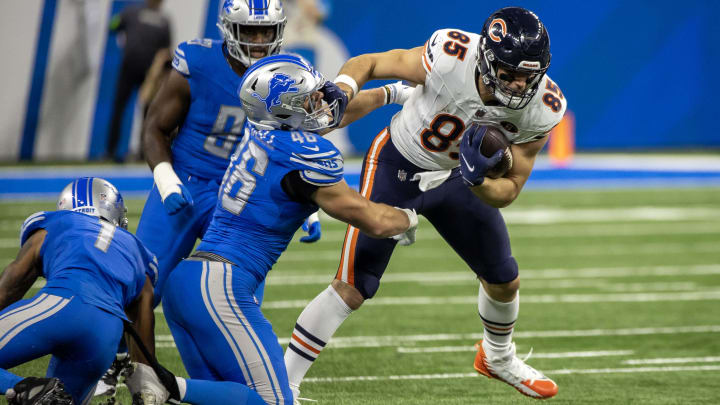Bears 2024 Training Camp Preview: Capable Tight Ends Overshadowed

Last year the Bears managed 88 receptions from their tight end position thanks mainly to a career-high 73 from Cole Kmet.
Even when they had Jimmy Graham in his last productive season and paired him with Kmet as a rookie (2020), they didn't have as many receptions from the tight end position as they had last year.
They didn't do it when Trey Burton had his one good season in 2018. They haven't had more receptions from all their tight ends combined since Martellus Bennett, Zach Miller, Rob Housler and Khari Lee combined to let them make 91 in 2015.
Had an awesome experience volunteering at Cole Kmet’s youth football camp in Lake Forest today! pic.twitter.com/Oj98sfX0jr
— Charlie Schleny (@cschleny) July 13, 2024
So with Kmet back under contract now long term, and dependable, experienced former starter Gerald Everett added to the tight end group, it's possible they'll realize their greatest receiving contribution from this group in a decade. Even though the team has three wide receivers possibly better than any trio they've ever had in Rome Odunze, Keenan Alllen and DJ Moore, the tight ends should be able to contribute.
One of the key ways is in the red zone as the bigger targets who are most recognizable for a rookie QB.
ALL NFC NORTH TEAM: WHAT THE BEARS OFFENSIVE LINE SAYS FOR GM RYAN POLES
"Certainly we gotta improve in that area," Eberflus said. "That's going to be a big part of our success, the red zone. I talked to the guys about the attention to detail down there. That's going to be ongoing."
Nephew is attending @ColeKmet #ProCamps today!! Kmet is his favorite player from @NDFootball to the @ChicagoBears!!
— nick stiglic (@NickStiglic) July 13, 2024
BEARDOWN & GOD BLESS!! pic.twitter.com/ZyFqESbwe2
The Bears weren't bad at scoring in the red zone. They were 15th in TD percentage (57.4%) and Kmet was among the league's best threats at the position inside the opposing 20 with five of his six TD catches coming there, to go with a high 73.3% catch/target ratio.
It's not simply last year's high catch total by Kmet that could lend itself to the position's value. They've put in their time in the league and can help in more ways than as receivers or, in Marcedes Lewis' case, a blocker.
Possibly the biggest way is by assisting a rookie quarterback at understanding what he's seeing from opposing defenses, and providing a short-range secondary target.
"You've got Cole who's got great experience," Bears coach Matt Eberflus said. "Everybody who's on the offense that has experience, we're gonna lean on those guys."
It's often said a tight end is a quarterback's best friend. It's because he's a potential open target not far away and usually directly in sight over the middle.
Watching Marcedes Lewis block is so much fun, and it's a shame he's wasting it in this Bears offense this season pic.twitter.com/1lB8BgCPbV
— Lorin Cox (@CoxSports1) September 26, 2023
Kmet knows this ways to contribute can extend beyond catching passes. They can calm a jumpy rookie as security blankets.
"I've played with a bunch of different quarterbacks at this point now," Kmet said. "So that's nothing new. Really just being patient with it. Kind of understanding that there's a learning process to it, and especially as a rookie, there’s a lot that you got to learn coming into the league.
"So I feel like (Williams has) done a great job so far throughout OTAs. You can see those steps he's taking week to week but, yeah, there's definitely an element of patience that there has to be just because of where he's at in his career. And that's totally understandable."
Ultimately, tight end will still be the secondary target of a rookie passer and possibly his best friend when the glamour trio at receiver isn't open.
It should be a dependable group with potential for bigger numbers if necessary. They give offensive coordinator Shane Waldron the desired ability to take advantage of matchups against defenses incapable of covering every possible effective target.
The fact they are overshadowed by the big names at receiver only plays into their hands as being a surprise element defenses struggle to contain.
Gerald Everett will be a helpful target for Caleb Williams in his rookie year.
— ChBearsUpdates (@chbearsupdates) July 1, 2024
Everett has been a consistent player throughout his career, and had his best season in 2022 with the Chargers. Now with the Bears, Everett is able to thrive alongside his former OC, Shane Waldron 👀 pic.twitter.com/5zhta4YHZw
Bears Tight End Outlook
Starters: No. 85 Cole Kmet
Backups: No. 14 Gerald Everett, No. 84 Marcedes Lewis
Roster Hopefuls: No. 88 Stephen Carlson, No. 87 Brenden Bates, No. 83 Tommy Sweeney
Strengths: Red zone receiving should be no problem with Kmet among the better tight ends there and Everett with 11 TD catches over the last three seasons for his teams. Especially in the short-to-intermediate range, the Bears tight ends should be very effective. Kmet has been among the better blocking tight ends they've had in recent years at the starting "Y" but also has improved his catch percentage every year in the league and QBs had a passer rating over 100 when they targeted him each of the last two years. He also has untapped potential after the catch, something he displayed in college. Everett also has catch-and-run possibility.
Weaknesses: There are no glaring weaknesses in the group but it could have been stronger with a speedier tight end at the move position besides Everett, who is dependable but not one of the faster seam attackers at this position in the league. Still, he has the hands and ability to get downfield. The injury possibility with 40-year-old Lewis as a blocking tight end does exist and Bates is supposed to be a solid blocker as rookies go, but rookie tight ends who go undrafted rarely assume big roles. If they have injuries at the position, they're basically counting on players who might not even be capable of making another team's roster.
Shane Waldron now has…
— Ben Devine (@Chicago_NFL) June 23, 2024
Caleb Williams
D’Andre Swift
DJ Moore
Keenan Allen
Rome Odunze
Cole Kmet
Gerald Everett#DaBears
pic.twitter.com/vOZCDvfZIu
Twitter: BearDigest@BearsOnMaven
